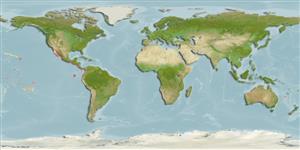Common names from other countries
Environment: milieu / climate zone / depth range / distribution range
पारिस्थितिकी
समुद्री प्रवाल-भित्ति संयुक्त; गहराई सीमा 3 - 68 m (Ref. 5227). Tropical
Eastern Pacific: Baja California to Peru, including the Galapagos and other offshore islands.
आकार / वज़न / Age
Maturity: Lm ? range ? - ? cm
Max length : 28.0 cm TL पुल्लिंग / अलिंग; (Ref. 5227)
पृष्ठीय रीढ़ (सम्पूर्ण): 3; पृष्ठीय सौफट रेज़ (सम्पूर्ण): 23-26; ऐनल सौफट रेज़: 16 - 18; जानवरों की रीड़ का जोड़: 24. Sides of body, excluding cheeks, mottled with cream to pale-brown blotches on dark background, reaching onto bases of median fins; blotches are poorly-defined and often coalescing. Body and head, excluding lips and maxillary, with embedded scales. Dorsal spines 3 (rarely 2). Lower jaw projecting, with prominent fleshy protuberance. Numerous, small pores, in patches, along ventral surface of lower jaw and on the free-edge of preopercle in > 6.5 cm SL specimens (Ref. 40934).
Lives in rocky reefs, sheltering in caves and crevices but also encountered in the open (Ref. 11482). Lies motionless, often on its side, hidden in dark recesses. Actively hunts at night, preying on small fish (Ref. 5227).
Life cycle and mating behavior
परिपक्व अवधि | पुनरुत्पत्ति | मछलीऔ का अंडे देना | अंडे | Fecundity | लार्वा
Allen, G.R. and D.R. Robertson, 1994. Fishes of the tropical eastern Pacific. University of Hawaii Press, Honolulu. 332 p. (Ref. 11482)
IUCN Red List Status (Ref. 130435)
CITES (Ref. 128078)
Not Evaluated
Threat to humans
Harmless
Human uses
अधिक जानकारी
आम नामउपशब्दचपायचयपरभक्षीईकोटोकसीकोलौजीपुनरुत्पत्तिपरिपक्व अवधिमछलीऔ का अंडे देनाFecundityअंडेEgg development
संदर्भजलीयकृषिजलीयकृषि रूपरेखाखींचआनुवंशिकीElectrophoresesहैरेटिबिलटीबीमारीप्रक्रमणMass conversion
सहयोगीयोतस्वीरेStamps, Coins Misc.ध्वनिसिगुयटिरारफ्तारतैरने के प्रकारगिल क्षेत्रOtolithsदिमागदृष्टि
साधन
Special reports
Download XML
इंटरनेट स्रोत
Estimates based on models
Preferred temperature (Ref.
115969): 20.6 - 28.9, mean 25.9 (based on 82 cells).
Phylogenetic diversity index (Ref.
82804): PD
50 = 0.5010 [Uniqueness, from 0.5 = low to 2.0 = high].
Bayesian length-weight: a=0.01738 (0.00680 - 0.04443), b=3.01 (2.78 - 3.24), in cm Total Length, based on LWR estimates for this (Sub)family-body shape (Ref.
93245).
Trophic level (Ref.
69278): 4.0 ±0.7 se; based on size and trophs of closest relatives
Fishing Vulnerability (Ref.
59153): Low vulnerability (18 of 100).
